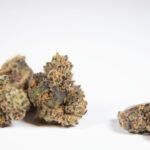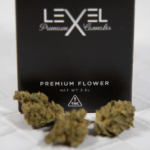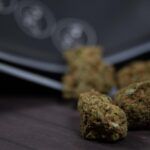Environmental Control and Potency
Indoor cultivation allows growers to precisely manage lighting, temperature, humidity, CO₂ levels, and nutrients. These tightly regulated environments—typically under LED or high-intensity lights—often produce flower with higher THC levels and denser, more uniform buds. Many indoor strains test near 30% THC. In contrast, outdoor-grown cannabis usually tops out closer to 25% due to variable environmental conditions.
Terpene Diversity and Aroma Complexity
Outdoor (sun-grown) cannabis generally offers more terpene complexity than indoor flower. Natural exposure to full-spectrum sunlight and varied environmental factors tends to enhance the expression of aromatic compounds, which contribute to flavor, scent, and the entourage effect. Lab comparisons have shown outdoor cannabis contains a broader range of terpenes, which are critical for the overall experience—even when THC content is slightly lower.
Yield, Structure, and Visual Appeal
Indoor growers use techniques like SCROG and SOG to create compact, bushy plants that deliver dense and visually appealing buds. Outdoor plants, by contrast, grow larger with more branching and often produce greater overall yields per plant. While outdoor buds might be less visually uniform, they can still be potent and flavorful, especially when grown organically in the right conditions.
Environmental and Regulatory Dimensions
Indoor growing is energy-intensive. It’s estimated that indoor cannabis cultivation accounts for a notable portion of electricity use in the U.S. and contributes significantly to carbon emissions. Outdoor cultivation, when responsibly managed, can be far more environmentally friendly, avoiding the HVAC and lighting systems that drive up energy use in indoor operations.
Pest, Mold & Chemical Exposure
Outdoor cannabis is exposed to natural threats like pests, mold, and inclement weather, but organic practices can reduce the need for harsh chemical treatments. Indoor cannabis, while shielded from weather, can suffer from mold or pest outbreaks due to enclosed conditions and often requires more chemical controls to maintain cleanliness and consistency.
Genetics & Terroir
Growing identical strains indoors versus outdoors can result in very different chemical profiles. This is due to “terroir”—a term borrowed from winemaking—which suggests that soil, climate, and environmental nuances affect how the plant expresses cannabinoids and terpenes. Some outdoor growers are now advocating for appellation-style labeling to reflect the regional uniqueness of their product.
Summary of Indoor vs. Outdoor Cannabis
- THC Potency
- Indoor: Typically higher, reaching up to 30%
- Outdoor: Slightly lower, averaging around 25%
- Terpene Complexity
- Indoor: More limited range of aromas
- Outdoor: Richer and broader terpene profiles
- Yield per Plant
- Indoor: Smaller individual yields, but consistent
- Outdoor: Larger plants, often more total yield per plant
- Visual Appearance
- Indoor: Dense, uniform, often more manicured
- Outdoor: Less uniform, may contain natural imperfections
- Batch Consistency
- Indoor: High level of control ensures uniformity
- Outdoor: Variability between crops due to weather and soil
- Sustainability
- Indoor: High carbon footprint, energy-demanding
- Outdoor: Lower emissions, more eco-friendly
- Pest and Mold Risks
- Indoor: Prone to mold if airflow is poor, chemical use common
- Outdoor: Natural pests and mold risks, but fewer chemicals when organic methods are used
- Influence of Terroir
- Indoor: Environmental impact minimized
- Outdoor: Soil and region can enhance aroma and quality
Why It Matters to Consumers and Connoisseurs
Indoor-grown cannabis appeals to those who prioritize maximum potency, aesthetics, and consistency—attributes prized in boutique flower markets and pre-rolls. Meanwhile, outdoor cannabis often attracts flavor-focused consumers, sustainability-minded buyers, and connoisseurs seeking regionally distinctive profiles. Both methods have their place in the market, with hybrid cultivation models emerging to combine the benefits of both.
Regardless of the environment, the key to top-shelf cannabis lies in the grower’s expertise, attention to curing, and commitment to clean cultivation. Whether it’s indoor sparkle or sun-grown flavor, the cultivation method plays a crucial role in shaping the final product’s quality, aroma, and impact.






